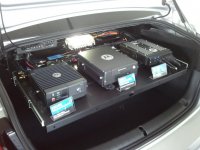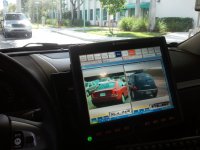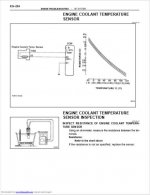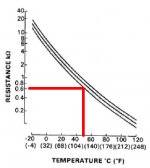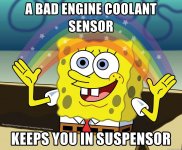Okay after thinking about it for a while I bought a spare air flow meter off ebay for $44.95. my primary suspect right now is a bad AFM.
It probably died because I messed with it too much with a screwdriver trying to lean out the air/fuel ratio.
YouTube
YouTube
YouTube
My car sounds just like the one in the FIRST and SECOND videos.
It probably died because I messed with it too much with a screwdriver trying to lean out the air/fuel ratio.
YouTube
YouTube
YouTube
My car sounds just like the one in the FIRST and SECOND videos.
Has the ECU got any sort of self diagnostics you can access? Sometime you just have to know the sequence to get them to flash out the codes on the dash (my wifes Barina, you did something like turn on the ignition with your foot flat on the accelerator and then touch the brake). I've had a wire come loose in the oxygen sensor which caused a misfire, so I think the fact you said you moved it, makes it a prime suspect.
In my car there is a two wire connector and you just have to short one of the wires for 1 second to start the sequence, shorting it again to get the next code.
More modern cars will have an OBD port and bluetooth OBD reader combined with a smart phone is invaluabe.
The ECU should be able to tell you where the problem is, eliminating the guesswork.
Tony.
In my car there is a two wire connector and you just have to short one of the wires for 1 second to start the sequence, shorting it again to get the next code.
More modern cars will have an OBD port and bluetooth OBD reader combined with a smart phone is invaluabe.
The ECU should be able to tell you where the problem is, eliminating the guesswork.
Tony.
I didn't catch it earlier, but what year is the car. In the USA all cars made after 1997 were required to meet the OBD2 standard. Europe followed by the early 2000. ALL OBD2 vehicles used the same OBD2 connector and used the same standard codes. If your car is 2000 or newer it should have an OBD2 connector.
Scanners to read these codes vary from free (download the schematic and PC software) to cheap (under $20), to expensive (over $100). You could borrow a scanner, or find a shop that will scan your car for a nominal fee.
My wife's check engine light came on while on a trip, so she stopped at a Walmart where they charged her $5 to scan the car. The scanner revealed that she had forgot to put the gas cap on after filling the tank!
Pre 2000 cars had OBD1 diagnostics which varied from make to make, and year to year. As stated there were different ways to get the codes to flash out on the check engine light. These were limited to two digits and often not very specific, but a place to start.
Note, my knowledge of these closed loop systems ended in the mid 90s before wide band (multiple wires) O2 sensors were common. The newer stuff has better "out of range control, but I am under the belief that this is an older car.
A faulty oxygen sensor can make a car run rich. Sometimes too rich to run at all. The oxygen sensor senses oxygen in the exhaust. A properly burned mixture should contain little oxygen. The sensor works by producing a voltage proportional to the oxygen content. An overly rich mixture can foul the sensor such that it produces no or low voltage, forcing the system to add even more fuel. Some fuel additives can also foul the sensor, as can excess oil or coolant in the exhaust. I learned the hard way that the 104+ Octane booster sold in the early 90's will foul an O2 sensor with some yellow coating that kills it.
We used to test them by connecting a digital voltmeter from the hot sensor wire to ground and going for a test drive. I don't remember the numbers but a dead sensor produced near zero volts, and a good one made somewhere around half a volt. Home later vehicles had a heater O2 sensor to allow the feedback loop to close earlier. These are similar to the older narrow band sensors with an extra wire connected to a switched 12 volt source.
A bad engine coolant, or incoming air temp sensor can also cause a car to run rich. The air temp sensor input was how we used to fool the early systems into giving us a bit more fuel so we could turn up the turbo boost.
If one or two specific cylinders are at fault, there are two ways to figure out which one is to blame. This is easiest by running the car in the misfire condition for a few minutes then pulling and checking the plugs. Sometimes one plug will obviously be colder to the touch if it wasn't firing at all. Other times one will be black and wet, while the others are grey and dry.
Pulling plug wires was a common test on 70's and older cars with a conventional distributor. This is not recommended on newer cars due to the higher voltages. If you do a plug wire test on a "wasted spark" (2 plugs per coil) system, you must ground the plug being tested. An open circuit will prevent the companion plug from firing.
When I was determining which cylinders were not firing on my Mustang it was easier to unplug fuel injectors, one at a time. Unplugging the injector on a properly firing cylinder will cause a drop in RPM and a noticeable engine vibration. A dead cylinder will exhibit no change, since it is already dead.
A head gasket can be blown between two adjacent cylinders and not leak water. This is somewhat common on aluminum headed engines. It's usually the middle two cylinders on an inline 4 cylinder since one is firing when the other has one or both valves open. Continued operation with this type of leak will ruin the head. A compression tester is the best diagnostic tool here.
Scanners to read these codes vary from free (download the schematic and PC software) to cheap (under $20), to expensive (over $100). You could borrow a scanner, or find a shop that will scan your car for a nominal fee.
My wife's check engine light came on while on a trip, so she stopped at a Walmart where they charged her $5 to scan the car. The scanner revealed that she had forgot to put the gas cap on after filling the tank!
Pre 2000 cars had OBD1 diagnostics which varied from make to make, and year to year. As stated there were different ways to get the codes to flash out on the check engine light. These were limited to two digits and often not very specific, but a place to start.
Note, my knowledge of these closed loop systems ended in the mid 90s before wide band (multiple wires) O2 sensors were common. The newer stuff has better "out of range control, but I am under the belief that this is an older car.
A faulty oxygen sensor can make a car run rich. Sometimes too rich to run at all. The oxygen sensor senses oxygen in the exhaust. A properly burned mixture should contain little oxygen. The sensor works by producing a voltage proportional to the oxygen content. An overly rich mixture can foul the sensor such that it produces no or low voltage, forcing the system to add even more fuel. Some fuel additives can also foul the sensor, as can excess oil or coolant in the exhaust. I learned the hard way that the 104+ Octane booster sold in the early 90's will foul an O2 sensor with some yellow coating that kills it.
We used to test them by connecting a digital voltmeter from the hot sensor wire to ground and going for a test drive. I don't remember the numbers but a dead sensor produced near zero volts, and a good one made somewhere around half a volt. Home later vehicles had a heater O2 sensor to allow the feedback loop to close earlier. These are similar to the older narrow band sensors with an extra wire connected to a switched 12 volt source.
A bad engine coolant, or incoming air temp sensor can also cause a car to run rich. The air temp sensor input was how we used to fool the early systems into giving us a bit more fuel so we could turn up the turbo boost.
If one or two specific cylinders are at fault, there are two ways to figure out which one is to blame. This is easiest by running the car in the misfire condition for a few minutes then pulling and checking the plugs. Sometimes one plug will obviously be colder to the touch if it wasn't firing at all. Other times one will be black and wet, while the others are grey and dry.
Pulling plug wires was a common test on 70's and older cars with a conventional distributor. This is not recommended on newer cars due to the higher voltages. If you do a plug wire test on a "wasted spark" (2 plugs per coil) system, you must ground the plug being tested. An open circuit will prevent the companion plug from firing.
When I was determining which cylinders were not firing on my Mustang it was easier to unplug fuel injectors, one at a time. Unplugging the injector on a properly firing cylinder will cause a drop in RPM and a noticeable engine vibration. A dead cylinder will exhibit no change, since it is already dead.
A head gasket can be blown between two adjacent cylinders and not leak water. This is somewhat common on aluminum headed engines. It's usually the middle two cylinders on an inline 4 cylinder since one is firing when the other has one or both valves open. Continued operation with this type of leak will ruin the head. A compression tester is the best diagnostic tool here.
VenusFly said:.... The "miss" isn't a miss at all. The tailpipe is flooded with fuel. ..... But now the sweet smelling exhaust has gone, replaced only by fuel. ....
The particular model of Jaguar V12 that I have is notorious for having one half of the dual plane distributor fail. When this happens, the engine becomes a smooth running, but down on power, inline 6. The relatively unsophisticated engine management system keeps the injectors firing on the bad bank, even though there is no ignition, the raw fuel goes into the cats on that side, and if they are hot, no more car.
When this happened to me, I caught it within seconds and shut down, and was still concerned I might lose the car.
Not sure about Toyota's, but I would be cautious about letting too much fuel get into the cats. At best it's bad for them. I would have the car outside when I was fooling with it, just in case ....
Good luck with this. But I think the ham rig should be number one on list two. My daily driver is a Holden, btw.
Win W5JAG
My daily driver is a Holden, btw.
Probably not unlike this one. The GTO (Monaro) and the G8 (Commodore) died with the Pontiac brand, but that didn't stop GM from making a few bucks.
This is the Motorola Cop Car, a modified Holden Commodore wearing Chevrolet badges and sold "only to fleet buyers" usually in police trim. Some were sold as "Chevrolet SS" to enthusiasts in an attempt to get the body style qualified for Nascar. I don't know if you can still get them.
This car was custom built as a rolling police technology showcase. There are all sorts of police type gizmos from a gun dispenser that will unlock the shotgun into the officer's hand but not allow anyone else to take it, to the latest radio tech, to the "big brother" machine (last picture).
The officer just needs to drive the car. Big Brother automatically scans every license plate in visibility and runs them through NCIC and other agency databases for "wants and warrants." Show it a DL or other form of ID from the in car camera and it will run those too.
I had a "discussion" with the guy driving the car about Chevrolet's lack of RWD for cop use. I was assured that it was indeed RWD and then offered a ride as proof. Astonished at the car's potential we opened the hood to reveal the 6.0L aluminum Escalade motor......The old saying from the 60's is still true........you can outrun the cop car, but you can't outrun Motorola.
Attachments
Last edited:
cool tubelab that thing runs Windows XP!
Yep. All Holden large family Sedans (and wagons) are RWD. In fact as of just 15 years ago it would be a common sight to see either in the news or on the side of the road a earlier model Holden Commodore wrapped around a telegraph pole OR a Ford Falcon. That was as a result of the rear end being driven by a solid transaxle and teenagers getting happy with the throttle.
Hence the reason why I own a FWD car today, I'm too scared of the power and ferocity of RWD solid transaxle cars, I can handle 200HP easily at the front wheels.
They have plenty of power and that is why I typically stay away from them even though down here you can get them for a dime a dozen. The first few cars that I owned were all Falcons, I've never owned a Holden.
My current car, the Toyota Vienta Grande VCV10 model "Widebody" (1993-1997), is down here in Australia rebadged as the Holden Apollo which was done under the button plan project to skip on import tarrifs and make cars cheaper.
Button car plan - Wikipedia
Holden Apollo - Wikipedia
I might end up one day owning a Holden as they are the only truly genuine Australian car left, every other car sold on the road is made in Asia and the profits go to Asia, which is a big deal among people here.
Diagnosis:
As for all of your kind words in regards to the idea that I should pull out a diagnostic tool, no such luck amigos. This is an OBD1 vehicle and as a result I will have to read the service manual that I downloaded a few days ago and learn how to do it old school grandpa style and stick a light globe into the "Diagnostic Port" inside of the engine bay located on the passengers side and bridge two pins in that same diagnostic port.
In Australia we didn't get OBD2 standard on cars until 2001!
I do have a list of diagnostic codes to read from from the service manual and I just woke up a few minutes ago ready to go and print them out.
And that is what I'm going to do this morning once the sun comes up and other people have woken up, probably around 8-9AM. Its currently 3:12AM.
I'm just glad that the car is reassembled, it was a big job putting all of that stuff back together yesterday and my bones ache. I'm probably going to watch a few episodes of the simpsons while I have breakfast and wake up.
Yep. All Holden large family Sedans (and wagons) are RWD. In fact as of just 15 years ago it would be a common sight to see either in the news or on the side of the road a earlier model Holden Commodore wrapped around a telegraph pole OR a Ford Falcon. That was as a result of the rear end being driven by a solid transaxle and teenagers getting happy with the throttle.
Hence the reason why I own a FWD car today, I'm too scared of the power and ferocity of RWD solid transaxle cars, I can handle 200HP easily at the front wheels.
They have plenty of power and that is why I typically stay away from them even though down here you can get them for a dime a dozen. The first few cars that I owned were all Falcons, I've never owned a Holden.
My current car, the Toyota Vienta Grande VCV10 model "Widebody" (1993-1997), is down here in Australia rebadged as the Holden Apollo which was done under the button plan project to skip on import tarrifs and make cars cheaper.
Button car plan - Wikipedia
Holden Apollo - Wikipedia
I might end up one day owning a Holden as they are the only truly genuine Australian car left, every other car sold on the road is made in Asia and the profits go to Asia, which is a big deal among people here.
Diagnosis:
As for all of your kind words in regards to the idea that I should pull out a diagnostic tool, no such luck amigos. This is an OBD1 vehicle and as a result I will have to read the service manual that I downloaded a few days ago and learn how to do it old school grandpa style and stick a light globe into the "Diagnostic Port" inside of the engine bay located on the passengers side and bridge two pins in that same diagnostic port.
In Australia we didn't get OBD2 standard on cars until 2001!
I do have a list of diagnostic codes to read from from the service manual and I just woke up a few minutes ago ready to go and print them out.
And that is what I'm going to do this morning once the sun comes up and other people have woken up, probably around 8-9AM. Its currently 3:12AM.
I'm just glad that the car is reassembled, it was a big job putting all of that stuff back together yesterday and my bones ache. I'm probably going to watch a few episodes of the simpsons while I have breakfast and wake up.
Last edited:
VenusFly. what make/model is your car?
On my 1991 Toyota Previa, I just had to jumper something on the diagnostic port and count the blinks of the check engine light when you turn the key to position II.
It can read out double digits and multiple codes. You just have to be good at counting.
On my 1991 Toyota Previa, I just had to jumper something on the diagnostic port and count the blinks of the check engine light when you turn the key to position II.
It can read out double digits and multiple codes. You just have to be good at counting.
Aka, Toyota Tarago here. I used to jam an LED into the socket to read out my 'Morse code'.On my 1991 Toyota Previa,
Okay what did I learn this morning?
The AFM is faulty. I checked its value with a digital multimeter and the value would never be stable and would constantly change in value by anywhere as little as 0.5 an ohm or 5 ohms in as little as a few seconds without even touching the AFM. I might've caused it by probably leaving the lid off of it for too long (and the contact somehow corroded), or maybe it was like that the whole time and the reason why the seller sold the car was because of a problem with it.
Anyway, its a good thing that I bought the spare AFM because I checked the resistance on the AFM contact brush and it was constantly varying by a few ohms. It was EXTREMELY sensitive to touch and every time that I placed my test leads onto the AFM terminals the value would change. There is our intermittent fault I think.
Even breathing on the AFM would change the resistance value read on the contact brush, not kidding. So obviously for a potentiometer that is a bad thing to be happening. Anyway I tried fixing it first by using isopropyl alcohol and some cotton buds and cleaning the contact surface, no change. I then tried using supercheap auto electrical contact cleaner, no change. I then bought out the Deoxit Fader F5, and that changed things a bit, the value went down to about 270 ohms and the value was a bit more stable but it still wasn't 100% stable. So I still look forward to the replacement AFM to arrive in the mail to at the very least completely count it out as a source of problems.
With the Deoxity Fader F5 I simply cut off a strip of A4 paper and stuck it underneath the contact brush and then run the brush backwards and forwards over the piece of A4 paper.
However I don't think that the problems stop there, I still think that the O2 sensor is bad as the tailpipe is still pumping out the fuel, but at least now the idle is slightly smoother than before.
After I have a rest I'm going to go back down and do the LED diagnostic test, I've been reading the paperwork that I printed out and its as simple as bridging two contacts and inserting a LED globe.
The AFM is faulty. I checked its value with a digital multimeter and the value would never be stable and would constantly change in value by anywhere as little as 0.5 an ohm or 5 ohms in as little as a few seconds without even touching the AFM. I might've caused it by probably leaving the lid off of it for too long (and the contact somehow corroded), or maybe it was like that the whole time and the reason why the seller sold the car was because of a problem with it.
Anyway, its a good thing that I bought the spare AFM because I checked the resistance on the AFM contact brush and it was constantly varying by a few ohms. It was EXTREMELY sensitive to touch and every time that I placed my test leads onto the AFM terminals the value would change. There is our intermittent fault I think.
Even breathing on the AFM would change the resistance value read on the contact brush, not kidding. So obviously for a potentiometer that is a bad thing to be happening. Anyway I tried fixing it first by using isopropyl alcohol and some cotton buds and cleaning the contact surface, no change. I then tried using supercheap auto electrical contact cleaner, no change. I then bought out the Deoxit Fader F5, and that changed things a bit, the value went down to about 270 ohms and the value was a bit more stable but it still wasn't 100% stable. So I still look forward to the replacement AFM to arrive in the mail to at the very least completely count it out as a source of problems.
With the Deoxity Fader F5 I simply cut off a strip of A4 paper and stuck it underneath the contact brush and then run the brush backwards and forwards over the piece of A4 paper.
However I don't think that the problems stop there, I still think that the O2 sensor is bad as the tailpipe is still pumping out the fuel, but at least now the idle is slightly smoother than before.
After I have a rest I'm going to go back down and do the LED diagnostic test, I've been reading the paperwork that I printed out and its as simple as bridging two contacts and inserting a LED globe.
Last edited:
the Toyota Vienta Grande VCV10 model "Widebody" (1993-1997), is down here in Australia rebadged as the Holden Apollo
There were three GM / Toyota vehicles made and sold in the US. There was a joint ventures factory in California called NUMMI, New United Motors Manufacturing. It ran from the mid 80's until the government takeover of GM around 2009. It died along with the Pontiac, Saturn and Hummer brands, as well as Saab and a few other GM owned casualties. The factory was bought at the fire sale, refit and now cranks out Tesla's electric cars.
They made a vehicle called the Toyota Corolla when it came out one door, and it had several GM names over the years as it came out the other door. They were called Chevrolet Novas, Chevrolet Prism, and Geo Prism. None ever sold anywhere the number of cars as the identical Toyota branded car.
The factory also made the Toyota Matrix / Pontiac Vibe. Both sold reasonably well. Some Toyota HiLux pickup trucks were made there. They were renamed the Toyota Tacoma, a name still used here today as is the Corolla.
Hence the reason why I own a FWD car today, I'm too scared of the power and ferocity of RWD
They both have their advantages and disadvantages. It comes down to what you are used to. I have driven cars of both flavors with far more power that the tires could put to the pavement. I preferred RWD on the drag strip, and FWD on the autocross track. I had no preference on the street, but it does take some time to get used to what you can get away with in a new vehicle of either persuasion. The more power it has, the longer the learning curve for any new ride.
Gm is evil I believe, had OBDII first, onstar, then a rolling terminator from what you’ve described...
What next?
Those Prisms were a great bargain, when people looking for a corolla would regularly overlook them in the classified ad.
I’ll bet the O2 sensor is just fine after the mixture is corrected, and allowed to burn off any contaminates. The O2 sensors are the first thing to show as “bad” with on board diagnostics.
What next?
Those Prisms were a great bargain, when people looking for a corolla would regularly overlook them in the classified ad.
I’ll bet the O2 sensor is just fine after the mixture is corrected, and allowed to burn off any contaminates. The O2 sensors are the first thing to show as “bad” with on board diagnostics.
Last edited:
The diagnostic test didn't throw any codes whatsoever. As far as the ECU is concerned everything is hunky dory. There is a test mode and a normal diagnostic mode on this car and I ran both tests and it didn't store any codes whatsoever.
However I also unplugged the front bank O2 sensor and it didn't change the tone or rpm of the engine at all.
Doing this also didn't throw any codes.
I'm going to run through the service manuals O2 sensor tests this afternoon.
Uploadfiles.io - 3vzfe.pdf
^ Here is a copy of the service manual by the way.
However I also unplugged the front bank O2 sensor and it didn't change the tone or rpm of the engine at all.
Doing this also didn't throw any codes.
I'm going to run through the service manuals O2 sensor tests this afternoon.
Uploadfiles.io - 3vzfe.pdf
^ Here is a copy of the service manual by the way.
Last edited:
Front bank O2 sensor is fine. Its producing voltage when I start the car, up to 0.9v. It also disappears quickly as soon as I turn the engine off.
Strangely however the O2 sensor settles at 0.8v, it should be at 0.5v....
I'm looking at you mr AFM.
I might be able to do a test on the rear bank O2 sensor tomorrow but not today.
EDIT: AHA! EUREKA!
The engine coolant water temperature sensor is out of specification!!!
Its reading 3.0k ohms when in fact it should be within 1.48k - 1.58 k ohms! (When tested at 80c, I did warm the car up earlier.)
Which means, if the computer thinks the car is still trying to warm up it will continue to dump fuel into the engine to warm it up. THIS IS WHAT THE PREVIOUS OWNER WAS COVERING UP with the butchered and hollowed out thermostat!!!
I think I've found my problem folks!!!
A faulty coolant temperature sensor!
And my problem appeared at about just the same time that I replaced the thermostat and did the big 3 wiring upgrade...
I can't be 100% sure it is the coolant temp sensor but it looks like it might be it. I was wondering to myself why the car was taking a while to warm up according to the thermostat reading inside of the car when I was running it today.
I'll pull the sensor out tomorrow and do a test on it.
Strangely however the O2 sensor settles at 0.8v, it should be at 0.5v....
I'm looking at you mr AFM.
I might be able to do a test on the rear bank O2 sensor tomorrow but not today.
EDIT: AHA! EUREKA!
The engine coolant water temperature sensor is out of specification!!!
Its reading 3.0k ohms when in fact it should be within 1.48k - 1.58 k ohms! (When tested at 80c, I did warm the car up earlier.)
Which means, if the computer thinks the car is still trying to warm up it will continue to dump fuel into the engine to warm it up. THIS IS WHAT THE PREVIOUS OWNER WAS COVERING UP with the butchered and hollowed out thermostat!!!
I think I've found my problem folks!!!
A faulty coolant temperature sensor!
And my problem appeared at about just the same time that I replaced the thermostat and did the big 3 wiring upgrade...
I can't be 100% sure it is the coolant temp sensor but it looks like it might be it. I was wondering to myself why the car was taking a while to warm up according to the thermostat reading inside of the car when I was running it today.
I'll pull the sensor out tomorrow and do a test on it.
Last edited:
I was wondering to myself why the car was taking a while to warm up according to the thermostat reading inside of the car when I was running it today.
Irrelevant to the test data as this engine has two temperature sensors, one for the thermostat on the dash which is located up on the intake maniifold and one for the EFI computer/ECU which is located down on the thermostat housing.
So what did we learn today? Well a reading of 3.0k Ohms on a Engine Coolant Temperature sensor is a bad thing because these sensors are NTC type and therefore reduce in resistance as the temperature rises. But the engine is all warmed up and has been running for a while and the coolant is at least 40 degrees centigrade. So why is the 3.0k Ohm not lower? Because the sensor is faulty.
This makes complete sense too in the sense that the computer is dumping fuel into the cylinders even though the engine is warm.
And this guy says so:
YouTube
YouTube
YouTube
And... don't touch AFM's. Don't ever touch the insides of an AFM, Don't even look in their general direction, and especially never ever take the cover off.
Last edited:
yep.
I've confirmed my findings this afternoon. The engine coolant temperature sensor is DEFINITLEY faulty.
It is reading with the ohm meter at 2.955 kOhms when the engine coolant housing is sitting at 47-50 degrees centigrade. As measured with my awesome little multimeter.
According to the charts below the ECT sensor should be measuring 0.6 kOhms.
I've confirmed my findings this afternoon. The engine coolant temperature sensor is DEFINITLEY faulty.
It is reading with the ohm meter at 2.955 kOhms when the engine coolant housing is sitting at 47-50 degrees centigrade. As measured with my awesome little multimeter.
According to the charts below the ECT sensor should be measuring 0.6 kOhms.
Attachments
Last edited:
I now suspect the rear bank O2 sensor. Today I'm going to go and confirm my findings by testing both as indicated by the service manual.
Its possible that it could've unplugged or the wire could've broken when I was back there working on the rear bank and moving things around.
Today/Yesterday I unplugged the rear bank injector connector on cylinder #1 and nothing changed in the tone of the engine. Not entirely sure what that means. But I did the same to the 3 front injectors and the engine tone changed/engine almost conked out.
It might be possible that the front bank O2 sensor is faulty. Who knows.
Its possible that it could've unplugged or the wire could've broken when I was back there working on the rear bank and moving things around.
Today/Yesterday I unplugged the rear bank injector connector on cylinder #1 and nothing changed in the tone of the engine. Not entirely sure what that means. But I did the same to the 3 front injectors and the engine tone changed/engine almost conked out.
It might be possible that the front bank O2 sensor is faulty. Who knows.
Last edited:
- Home
- Member Areas
- The Lounge
- The car thread



